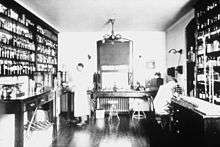Joseph J. Kinyoun
| Joseph J. Kinyoun | |
|---|---|
.jpg) Joseph J. Kinyoun | |
| Born |
November 25, 1860 East Bend, North Carolina |
| Died |
February 14, 1919 (aged 58) Washington, D.C. |
| Resting place |
Centerview Cemetery 38°45′01.8″N 93°50′38.7″W / 38.750500°N 93.844083°W |
| Fields | Bacteriology, Public health |
| Institutions |
Marine Hospital Service George Washington University |
| Alma mater | Bellevue Medical College |
| Known for |
|
| Influences | Robert Koch |
Joseph James Kinyoun MD (November 25, 1860 – February 14, 1919) was founder and first director 1887-1899 of the United States' Hygienic Laboratory, the predecessor of the National Institutes of Health.[1]
Biography
Early life
Joseph James Kinyoun was born November 25, 1860 in East Bend, North Carolina, the oldest of five children born to Elizabeth Ann Conrad and John Hendricks Kinyoun. The family moved to Johnson County, Missouri, in 1866, where the elder Kinyoun was a physician.[2]
Kinyoun was educated at St. Louis Medical College and graduated from Bellevue Medical College in 1882. He did postdoctoral studies in pathology and bacteriology at the Carnegie Laboratory[3] and in Europe under Robert Koch. He was awarded a Ph.D. from Georgetown University in 1896.
Career

.jpg)
Dr. Kinyoun began his career in the Marine Hospital Service as an assistant surgeon, taking over direction of the Laboratory of Hygiene in 1887.[4] When the Surgeon General moved the laboratory from Staten Island to Washington, DC in 1891, Kinyoun moved as well.
In 1899, he became head of the Marine Hospital Service in San Francisco. In March 1900 he was central to the discovery of the San Francisco plague of 1900–1904. He resigned his position in 1901 after allegations that his conclusive bubonic plague diagnoses were scaremongering. He was proven correct by independent testing and the appearance of further cases. Kinyoun's later career was spent in private companies and as a professor of bacteriology and pathology at George Washington University[3] before becoming a bacteriologist for the District of Columbia Health Department, a position he held until his death. In 1909, Dr. Kinyoun served as president of the American Society for Microbiology. He is perhaps best known now for the dissemination of the Kinyoun modification of the Ziehl-Neelsen stain for Acid-fast bacteria.[5]
Marriage and children
James and Susan Elizabeth "Lizzie" Perry married in 1883. The couple had at least four children: Joseph Perry Kinyoun; Alice Kinyoun Houts; Conrad Kinyoun; and John Nathan Kinyoun.
Death and afterward
Joseph Kinyoun died on February 14, 1919, in Washington, DC.
A collection of his papers is held at the National Library of Medicine.[6]
Awards
The National Institute of Allergy and Infectious Diseases' Joseph J. Kinyoun Memorial Lecture is named in his honor.
See also
References
- ↑ "Birth of the Hygienic Laboratory". Origins of the National Institutes of Health. U.S. National Library of Medicine. May 8, 1987.
- ↑ "Kinyoun, John H. (1825-1903), Account Books, 1859-1898 (C3863)" (PDF). The State Historical Society of Missouri.
- 1 2 Bing, Richard J. (2010). "The National Institutes of Health and Joseph J. Kinyoun" (PDF). Heart News and Views. 17 (3). International Society for Heart Research. p. 7.
- ↑ Luiggi, Cristina (2011-05-28). "One-Man NIH, 1887". The Scientist.
- ↑ Kinyoun JJ. 1915. A note on Uhlenhuths method for sputum examination, for tubercle bacilli. Am. J. Public Health 5:867–870.
- ↑ "Joseph J. Kinyoun Papers 1899-1939". National Library of Medicine.
External links
- Works by or about Joseph J. Kinyoun at Internet Archive
- "Joseph James Kinyoun". Founder of NIH Laboratory of Hygiene, Medical Doctor. Find a Grave. February 14, 2009. Retrieved June 4, 2013.
- "Joseph James Kinyoun, M.D.". The NIH Almanac. Chronology of NIH Directors. National Institutes of Health (NIH).
- Luiggi, Cristina (June 4, 2011). "One-Man NIH, 1887". The Scientist.